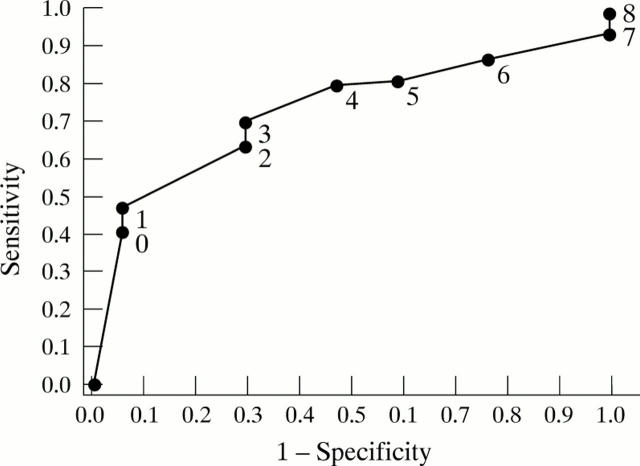Abstract
Background—Helicobacter pylori eradication therapy is routinely used for treating patients with peptic ulcer disease. Aims—To assess the value of symptomatic response to H pylori eradication therapy as a marker of post-treatment H pylori status. Patients and methods—One hundred and nine dyspeptic patients with active duodenal or gastric ulceration associated with H pylori infection had their symptoms measured by a validated questionnaire before and three months following H pylori eradication therapy. The symptomatic response was compared with post-treatment H pylori status as determined by the 14C urea breath test. Results—An eradication rate of 84% was achieved. Of the 92 patients eradicated of H pylori, 47% experienced complete or near complete resolution of dyspepsia. Of the 17 patients in whom the infection was not eradicated, only one (6%) experienced resolution of dyspepsia. Resolution of dyspepsia was therefore a powerful predictor of eradication of H pylori with a predictive value of 98%. In contrast, persistence of dyspepsia was a weak predictor of persisting infection with a predictive value of only 25%. Excluding patients with endoscopic evidence of coexisting oesophagitis and/or retrosternal discomfort or reflux at initial presentation did not increase the predictive value of persisting dyspepsia for persisting infection. Conclusions—Complete resolution of dyspeptic symptoms is a powerful predictor of eradication of H pylori infection in ulcer patients. Persistence of symptoms is a weak predictor of persisting infection and patients with persisting dyspepsia must have their H pylori status rechecked to guide future management.
Keywords: Helicobacter pylori; dyspepsia; ulcer disease; eradication therapy; reflux disease
Full Text
The Full Text of this article is available as a PDF (102.1 KB).
Figure 1 .
Individual dyspepsia scores in the ulcer patients before and after successful and unsuccessful H pylori eradication therapy.
Figure 2 .
ROC curve for various post-treatment dyspepsia scores for predicting eradication of H pylori.
Selected References
These references are in PubMed. This may not be the complete list of references from this article.
- Agréus L., Svärdsudd K., Nyrén O., Tibblin G. Irritable bowel syndrome and dyspepsia in the general population: overlap and lack of stability over time. Gastroenterology. 1995 Sep;109(3):671–680. doi: 10.1016/0016-5085(95)90373-9. [DOI] [PubMed] [Google Scholar]
- Boyd E. J. The prevalence of esophagitis in patients with duodenal ulcer or ulcer-like dyspepsia. Am J Gastroenterol. 1996 Aug;91(8):1539–1543. [PubMed] [Google Scholar]
- Johannessen T., Petersen H., Kleveland P. M., Dybdahl J. H., Sandvik A. K., Brenna E., Waldum H. The predictive value of history in dyspepsia. Scand J Gastroenterol. 1990 Jul;25(7):689–697. doi: 10.3109/00365529008997594. [DOI] [PubMed] [Google Scholar]
- Johnsen R., Bernersen B., Straume B., Førde O. H., Bostad L., Burhol P. G. Prevalences of endoscopic and histological findings in subjects with and without dyspepsia. BMJ. 1991 Mar 30;302(6779):749–752. doi: 10.1136/bmj.302.6779.749. [DOI] [PMC free article] [PubMed] [Google Scholar]
- Klauser A. G., Schindlbeck N. E., Müller-Lissner S. A. Symptoms in gastro-oesophageal reflux disease. Lancet. 1990 Jan 27;335(8683):205–208. doi: 10.1016/0140-6736(90)90287-f. [DOI] [PubMed] [Google Scholar]
- Marshall B. J., Warren J. R., Francis G. J., Langton S. R., Goodwin C. S., Blincow E. D. Rapid urease test in the management of Campylobacter pyloridis-associated gastritis. Am J Gastroenterol. 1987 Mar;82(3):200–210. [PubMed] [Google Scholar]
- Neithercut W. D., Milne A., Chittajallu R. S., el Nujumi A. M., McColl K. E. Detection of Helicobacter pylori infection of the gastric mucosa by measurement of gastric aspirate ammonium and urea concentrations. Gut. 1991 Sep;32(9):973–976. doi: 10.1136/gut.32.9.973. [DOI] [PMC free article] [PubMed] [Google Scholar]
- Phull P. S., Halliday D., Price A. B., Jacyna M. R. Absence of dyspeptic symptoms as a test of Helicobacter pylori eradication. BMJ. 1996 Feb 10;312(7027):349–350. doi: 10.1136/bmj.312.7027.349. [DOI] [PMC free article] [PubMed] [Google Scholar]
- Reilly T. G., Ayres R. C., Poxon V., Walt R. P. Helicobacter pylori eradication in a clinical setting: success rates and the effect on the quality of life in peptic ulcer. Aliment Pharmacol Ther. 1995 Oct;9(5):483–490. doi: 10.1111/j.1365-2036.1995.tb00410.x. [DOI] [PubMed] [Google Scholar]
- Solcia E., Villani L., Fiocca R., Luinetti O., Boldorini R., Trespi E., Perego M., Alvisi C., Lazzaroni M., Bianchi Porro G. Effects of eradication of Helicobacter pylori on gastritis in duodenal ulcer patients. Scand J Gastroenterol Suppl. 1994;201:28–34. [PubMed] [Google Scholar]
- Talley N. J., Weaver A. L., Tesmer D. L., Zinsmeister A. R. Lack of discriminant value of dyspepsia subgroups in patients referred for upper endoscopy. Gastroenterology. 1993 Nov;105(5):1378–1386. doi: 10.1016/0016-5085(93)90142-y. [DOI] [PubMed] [Google Scholar]
- el-Omar E. M., Banerjee S., Wirz A., McColl K. E. The Glasgow Dyspepsia Severity Score--a tool for the global measurement of dyspepsia. Eur J Gastroenterol Hepatol. 1996 Oct;8(10):967–971. doi: 10.1097/00042737-199610000-00006. [DOI] [PubMed] [Google Scholar]
- el-Omar E. M., Penman I. D., Ardill J. E., Chittajallu R. S., Howie C., McColl K. E. Helicobacter pylori infection and abnormalities of acid secretion in patients with duodenal ulcer disease. Gastroenterology. 1995 Sep;109(3):681–691. doi: 10.1016/0016-5085(95)90374-7. [DOI] [PubMed] [Google Scholar]




